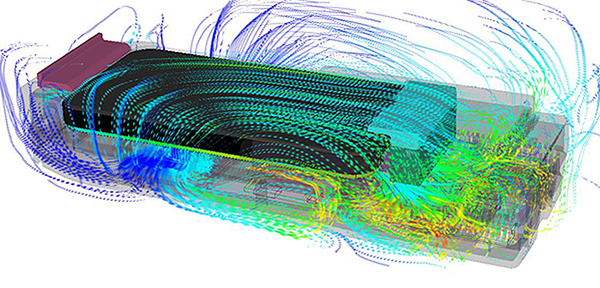The design priorities shaping thermal management in 2019
Over the next five years a flurry of new innovations and technology trends are coming into the mainstream with major implications for the world of electronics engineering. From Artificial Intelligence (AI) to edge computing, 5G to the Internet of Things (IoT), new technologies are redefining the ways that we live, work and communicate. Tom Gregory, Product Manager, Future Facilities explains.
While all of these advancements offer significant opportunities for the electronics industry, they also present a number of challenges when it comes to creating reliable, durable products. At the heart of these challenges is a renewed concern around thermal management.
Already, 6SigmaET’s research suggests that as many as one in five engineers have had their products derailed or delayed as a result of unexpected thermal complications. Now, as new technology trends demand ever-faster, smaller, more powerful and multi-functional electronics, the potential for thermal complications is only going to get worse. As a result, engineers need to think carefully about how they can incorporate thermal management into their designs and the tools and techniques they can use to minimise the potential for thermal complications.
The changing nature of electronics
Both at the consumer and the enterprise level, today’s electronics devices are expected to be smaller, slimmer, lighter and more powerful than ever before. Shrinking device sizes continue to dominate as a major design trend in 2019, but with ever-more components squeezed together and with space for airflow limited, designers are faced with inevitable thermal complications.
To overcome these challenges, designers must think far more carefully about their device layouts, taking advantage of every opportunity to optimise thermal design. Instead of relying on physical testing and prototypes, this means running multiple thermal simulations as early on in the design process as possible. Some thermal simulation software companies, including 6SigmaET, are even offering the option to review thermal simulations through Virtual Reality (VR), allowing engineers to get a whole new perspective of their designs and spot previously undetected opportunities to optimise airflow.
AI
2019 has been the year that Artificial Intelligence became a reality, with AI being incorporated into everything from retail recommendations to driverless cars. Behind this powerful new tool however, is a whole generation of increasingly powerful processors and complex hardware solutions. From a thermal perspective, this dramatic increase in processing represents a minefield of potential complications, with increased power typically meaning more heat output.
Already, leading electronics brands are looking for new ways to manage this increase in heat, with AI hardware such as the Google TPUv3 incorporating liquid cooling alongside its existing thermal management considerations. This represents the first time that Google has needed to incorporate a form of liquid cooling into its data centres - something which we expect to see ever-more of as AI hardware and data storage evolves.
IoT
The IoT has seen wireless connectivity added to a whole host of day-to-day objects, from street lights to clothing. In doing so, the IoT brings a number of new thermal challenges, with many of these devices operating in harsh, portable and industrial environments. In the case of wearable IoT devices, thermal engineers must think carefully about how their devices operate, ensuring that they are both light enough and cool enough to comfortably wear - without compromising on reliability.

Above: If engineers are going to adopt the latest trends, and still produce products that are reliable in the long-term, they need to move thermal simulation to the front of the queue
At the opposite end of the scale, many industrial IoT devices are bringing complex electronics into harsh environments with constantly changing temperatures. In some cases, this includes devices designed to operate at high altitude or even underwater, introducing numerous thermal and airflow considerations. At the same time, the new 5G infrastructure is also helping to cement the usefulness of IoT devices, bringing with it yet more complex hardware that will require adequate cooling solutions.
What's next?
With all of these trends hitting the mainstream in 2019, designers and engineers must look for new and increasingly innovative ways to manage the thermal outputs of their designs. At the heart of this change will be a need to think about thermal management earlier on in the design process.
As electronics devices grow more complex, it will no longer be enough to treat thermal management as an afterthought or part of the late-stage testing process. Instead, engineers must build thermal considerations into their designs from the very start, running multiple simulations to tweak and optimise their designs long before a prototype is produced.
Unfortunately, as it stands, 6SigmaET’s research suggests that more than half (56%) of engineers aren’t testing the thermal operation of their designs until after the first prototype has been produced. A further 27% aren’t doing so until after a design has been completed. If engineers are going to adopt the latest trends, and still produce products that are reliable in the long-term, they need to overcome this mentality and move thermal simulation to the front of the queue.







